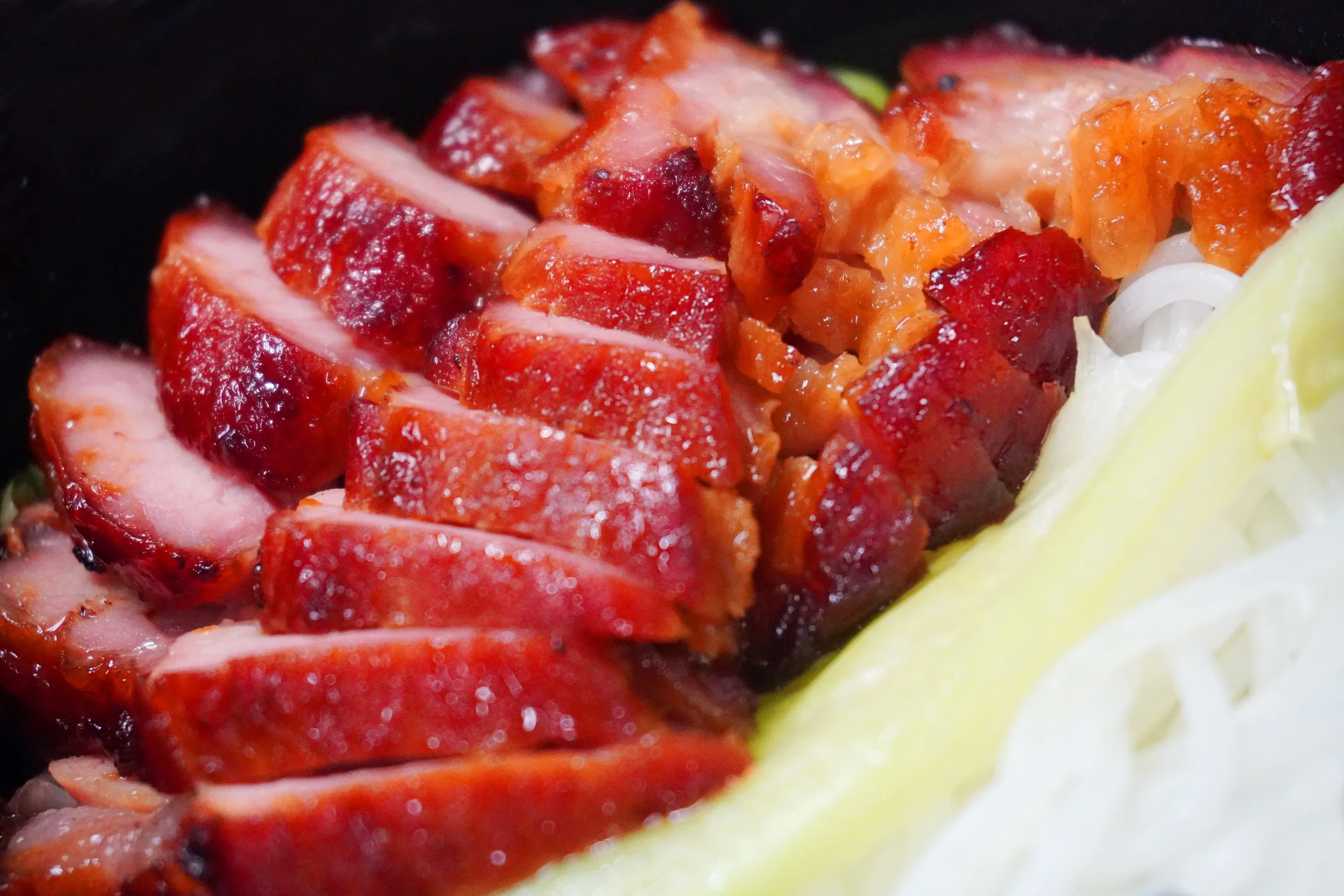Chinese cuisine is one of the world’s oldest and most diverse cuisines, comprising foods originating from China. Chinese meals include four main food groups — fruits, vegetables, grains and meat. These dishes don’t contain large amounts of dairy. Instead, they typically include calcium- and protein-rich alternatives like tofu and soymilk.
We can see that Chinese cuisine has greatly influenced many other foods throughout Asia and beyond. In addition to food, Chinese dining practices have also inspired the use of utensils like chopsticks and woks. Here’s your complete guide to Chinese cuisine, including origins, popular dishes and recipes.
Chinese Cuisine History
Chinese cuisine is one of the oldest in the world. It is believed to have originated in the central part of China and is one of three cuisines — the others being Turkish and French — that influenced dishes in countries throughout East Asia.
China was one of the first Asian civilizations to accomplish regular growth and stability. It acquired a distinctive taste in cuisine, allowing its dishes to grow and evolve at an impressive pace. Several factors contribute to China’s high attention to culinary detail, diverse cuisines and mainstreaming of dishes, including:
- The Han culture’s rapid expansion from the Yellow River across China.
- The absorption of foreign cuisine traditions through trading and expansions.
- The popularization of merging herbal medicine with cooking for more balanced meals.
- The constantly shifting cooking trends demanded by Chinese elites and imperial courts.
Chinese Food Culture
Food is fundamental in Chinese culture and everyday life. The Chinese believe that eating good food fosters unity and togetherness among families, forging stronger relationships.
Chinese cooking involves shopping for fresh foods daily. That means selecting the freshest meats, in-season produce and live seafood. Chinese culture emphasizes the dish’s flavor, color, aroma and texture. These are the essential building blocks of a delicious meal and tasting experience.
Traditionally, frozen and canned foods are rarely consumed, and Western desserts like pies, cakes, ice cream, and cookies are only enjoyed on special occasions like weddings, holidays, and birthdays.
Popular Chinese Cuisines by Region
Each region in China has its own cooking and dining habits due to geographical and climate differences. Finding foods based on your body’s needs in relation to geographical location is part of the yin and yang philosophy. For example, because Southern China has a more tropical climate, people in this area tend to prefer cooler and milder foods — or “yin” foods — to reduce the dryness and heat.
Meanwhile, Northern China has a damper, chillier climate. People here tend to prefer hotter and spicier foods — or “yang” foods — like chili peppers, garlic and onion. They believe these ingredients will reduce coldness and dampness and boost blood circulation.
China comprises 23 provinces, each with its own cooking style based on local preferences and ingredients. These morsels range from fresh, salty fish to hot and spicy chili peppers. Here are some examples of Chinese cuisine:
1. Sichuan
The Sichuan region is known for its humidity, allowing peppers to grow abundantly. Sichuan chefs incorporate peppers into many of their dishes. The Sichuan pepper is incredibly spicy, causing a tingly, mouth-numbing sensation. It’s perfect for those who don’t shy away from dishes with some kick.
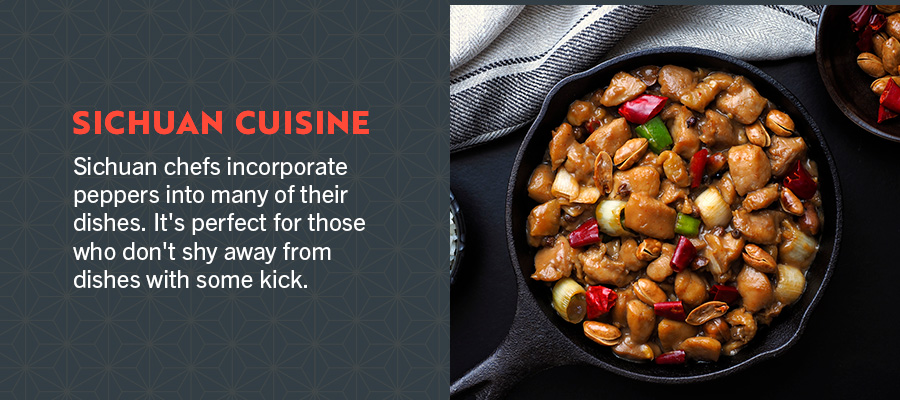
Pork, mushrooms and potent herbs are also prevalent in many Sichuan dishes and add a touch of umami. Below are some quintessential dishes from the Sichuan province:
- Kung pao chicken
- Wontons in red chili oil
- Sichuan hot pot
- Dan dan noodles
- Twice-cooked pork
2. Cantonese
Cantonese food is far milder than Sichuan cuisine, making it perfect for those who prefer less spice. Garlic is among the most prevalent flavors in Cantonese dishes. You’ll also find seasonings and herbs like ginger, cloves, green onions and chili powder.
Plum, sweet-and-sour, oyster and bean sauces provide the rich flavors Cantonese cuisine is known for. Some beloved Cantonese dishes include:
- Roast duck
- Sweet-and-sour pork
- Creamed corn soup
- String bean chicken
- Char siu (barbecued pork)
3. Fujian
Fujian cuisine is known for its light, soft, tender and umami flavor profile. Soup is a staple in this region, as is seafood with variations on oyster and fish dishes. Its seafood dishes are usually on the spicy side but not overly hot. Fujian is a coastal area and was historically an escape for refugees, which is why its dishes pull inspiration from numerous regions and countries.
Fujian cuisine features a variety of cooking techniques, such as braising, frying and simmering. Here are some Fujian classics:
- Red wine chicken
- Oyster omelets
- Stuffed fish balls
- Stewed ginger duck
4. Hunan
Hunan dishes are the optimal blend of spicy and sour. They generally include ingredients like ginger, garlic and chili peppers.
These dishes strongly resemble Sichuan cuisine in terms of flavor profile. However, Hunan cuisine tends to use less oil since it uses fresher ingredients. Sichuan cuisine steers toward dryer ingredients.
Hunan dishes commonly use cooking methods like steaming, smoking, sauteing and stir-frying. Some notable meals from this region are:
- Steamed fish head with chopped chili
- Red braised pork
- Stinky tofu (fermented tofu)
- Pearl meatballs
5. Jiangsu
Jiangsu cuisine is the epitome of umami. It also features a hint of sweetness for a subtle, delicate and well-rounded flavor profile. These dishes’ ingredients — down to their colors — shift to match the changing seasons. Texture, hue and temperature are all key to creating the perfect Jiangsu dish.
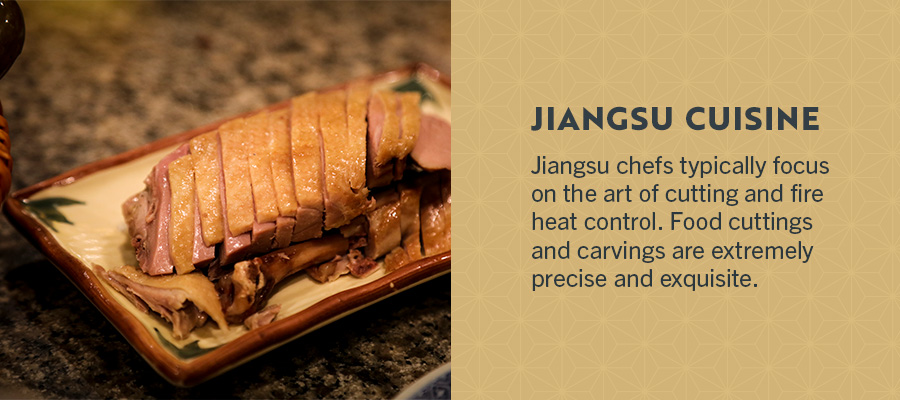
Jiangsu chefs typically focus on the art of cutting and fire heat control. Food cuttings and carvings are extremely precise and exquisite. They also incorporate techniques like stewing, simmering and braising. Fish is a primary base in many of these dishes, as they are traditionally cooked near the sea. They also emphasize natural meat and veggie flavors.
Here are some popular dishes in the Jiangsu province:
- Sweet and sour Mandarin fish
- Braised meatballs in brown sauce
- Nanjing salted duck
- Yangzhou fried rice
- Stewed tortoise and chicken
6. Shandong
Shandong cuisine is known for its crispy textures and salty flavor profile. Ingredients like soy sauce, salt and vinegar help achieve these flavors. This cuisine also uses a wide range of seafood, such as rockfish and sea cucumbers.
Here are some popular dishes from the Shandong region:
- Braised sea cucumber
- Spicy stir-fried clams
- Sweet-and-sour carp
- Cuttlefish roe soup
- Steamed stuffed tofu
The Flavor Profiles of Chinese Cuisine
Ancient Chinese medicine believes that consuming certain flavors can help with organ function and illness recovery. Chinese cuisine involves five main taste profiles, and Chinese medicine practitioners have found that each flavor has its own functions for human health:
- Sweet: Sweet flavors help nourish the stomach, pancreas and spleen. “Sweet” describes whole, natural foods instead of refined sugar. These ingredients include sweet potatoes, fruits, carrots, cabbages, chestnuts and whole grains.
- Sour: Sour flavors help strengthen the liver and gall bladder. These foods include sourdough bread, lemon, lime, sauerkraut and vinegar.
- Bitter: Bitter flavors help stimulate the heart and small intestine. These foods include collard greens, parsley, kale, celery, corn and sesame seeds.
- Spicy: Spicy flavors are known to benefit lung and colon health, though excess spice can aggravate the intestines. In moderation, spicy foods like wasabi, onions, ginger, scallions and horseradish can stimulate blood flow.
- Salty: Salty flavors help strengthen the kidneys and bladder. These ingredients include brine pickles, sea salt, miso and sea vegetables.
Westernized Chinese dishes often employ sweeter, heavier flavors than authentic Chinese cuisine. When it comes to Americanized and new Chinese cuisine, you’ll usually find more sugar, sodium and soy sauce and far less spice. Conversely, traditional Chinese dishes focus on fragrant spices that engage the senses and tastebuds more deeply.
6 Traditional Chinese Food Recipes
If you’re looking to indulge in some traditional Chinese cuisine, we’ve crafted this list of tasty recipes to help inspire your next feast.
1. Dumplings
While the exact origins of dumplings are unclear, experts believe Zhang Zhongjing — a Chinese medicine practitioner from the Eastern Han Dynasty — invented these pillowy treats. Han was China’s second imperial dynasty that lasted from 206 B.C. to 220 A.D.
Winter was brutal in this region, so Zhongjing wrapped herbs, mutton and chilis in dough, steaming them to bind the ingredients together. The steamy dumplings warmed people up, while the herbs helped increase blood circulation and prevent frostbite.
This dish has countless variations if you’d like to try making dumplings yourself. For example, these turkey rice paper dumplings with cranberry dipping sauce make a swoon-worthy hors d’oeuvre for any meal. They combine ingredients like shredded turkey, mixed veggies, Tamari Soy Sauce and other tasty seasonings into rice paper wrappers.
Finally, you top it all off with a sweet yet savory cranberry sauce for an incredible medley of flavors. Head over to the recipe and try it for yourself — you won’t regret it!
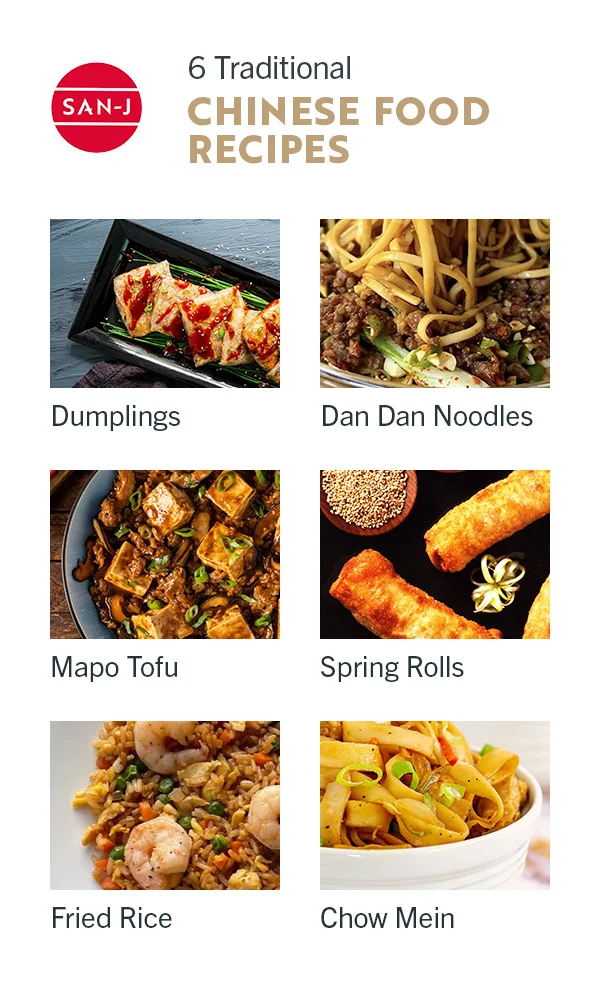
2. Dan Dan Noodles
Dan dan noodles started as a humble street food in Sichuan. The name translates to “noodles carried on a pole,” as vendors carried these noodles on bamboo poles.
This recipe consists of three main parts — pork, your choice of Asian noodles and a palatable sauce to top off the ensemble. Ingredients like Tamari Soy Sauce, Sichuan chili flakes, honey, ground pork and fresh spices come together to create a seamless blend of sweet, spicy and umami.
Garnishes like crushed peanuts and sliced green onions add just the right crunch and texture. Whether you’re seeking weeknight meals for the whole family or cooking for one, Dan dan noodles won’t disappoint. Consider making this meal to experience these unique flavors come together.
3. Mapo Tofu
Mapo tofu is a popular dish from the Sichuan province. It consists of tofu and minced meat — usually beef — in a thin, bright red sauce. There are also vegan- and vegetarian-friendly versions of this dish, such as this plant-based mapo tofu.
Featuring plant-based burger ground, minced mushrooms, Tamari, ground Szechuan peppercorn and a spicy bean sauce, this dish will have your tastebuds tingling with delight.
4. Spring Rolls
Spring rolls are thin pastries stuffed with vegetables, then deep-fried for a rich golden color. They date back to the Eastern Jin Dynasty, which reigned from 265 A.D. to 420 A.D. The Chinese would create this dish to commemorate the first day of spring, hence its name.
Traditionally, spring rolls resembled thin pancakes more than rolls. As cooking techniques evolved during the Ming Dynasty (1368-1644 A.D.), cooks began to roll these pancakes into the cylindrical shapes widely known today. Besides being simple to eat, spring rolls’ shape represents gold bars, wealth and prosperity.
If you need an appetizer to serve alongside your meal, give these Asian fried spring rolls a try. This recipe calls for ingredients like fresh veggies and spices, ground pork and Tamari, perfectly nestled into some spring roll wrappers for a palate-pleasing concoction. We don’t doubt that one crunch into this crispy treat will have you instantly reaching for another!
5. Fried Rice
Fried rice is believed to originate from the city of Yangzhou in the eastern Jiangsu province. It was a favorite dish of Emperor Yang of the Sui Dynasty (581-618 A.D.). Peasants in this era also made this dish to use up leftovers and prevent food waste, using ingredients like day-old rice, vegetables and eggs.
Fried rice can include virtually any combination of meats, seafood, veggies and seasonings to suit your culinary preferences. For instance, this shrimp fried rice features carrots, yellow onions, peas, white Jasmine rice, shrimp and Tamari Soy Sauce. This recipe makes an ideal side dish or main course.
6. Chow Mein
Chow mein comes from Taishan, a Cantonese-speaking province in Southern China. It consists of stir-fried noodles, veggies, and sometimes meat or tofu. Variations of this dish have appeared in numerous regions of China over the centuries, comprising various toppings and noodle-frying methods.
Chow mein largely resembles lo mein, another noodle-based dish originating from Northern China. While these dishes use similar ingredients, they differ in their cooking techniques. Chow mein noodles are soaked in hot water to soften them up before they are stir-fried.
Lo mein noodles are fully cooked before getting mixed with the vegetables, meat and sauce. The noodles are lightly mixed and tossed rather than stir-fried. Lo mein also has a chewier, smoother texture due to being fully cooked, while chow mein noodles are slightly crunchier.
This chow mein recipe merges ingredients like cabbage, celery, green onions, carrots, gluten-free noodles and chicken for a flavorful main course. It also features a sauce with Tamari, chicken broth, brown sugar and sesame oil for a mouthwatering topper.
Experience Asian Flavors at Home With San-J
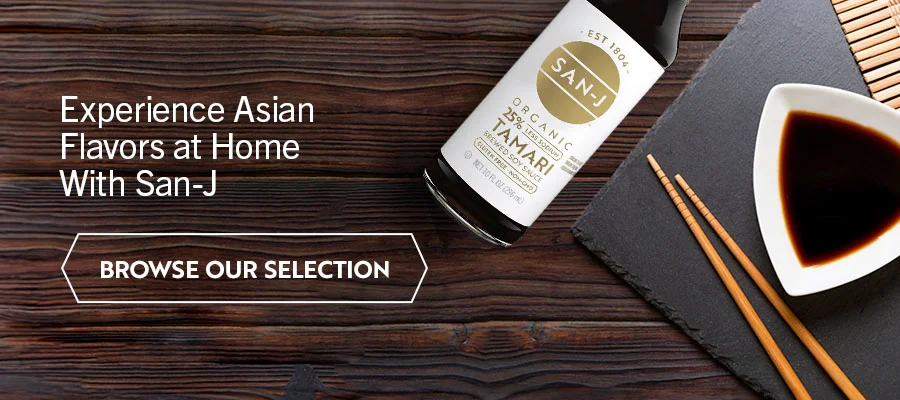
After browsing this guide, we hope you’ve found some recipes to add to your must-try list. You might have noticed that they call for Tamari Soy Sauce. This soybean-based condiment adds a smooth yet rich splash of umami to any Chinese dish, from meats and tofu to soups, pasta and vegetables.
San-J Tamari Soy Sauce is a premium, wheat-free sauce brewed with 100% soy. Our Tamari Soy Sauce contains no artificial preservatives, flavors, or colors. It is also available in reduced-sodium variations. Additionally, our Tamari is:
- Certified gluten-free by the Gluten-Free Certification Organization
- Non-GMO verified by the Non-GMO Project
- Certified kosher by Orthodox Union
- Certified vegan by Vegan Action
- With three varieties certified Organic by USDA Organic and Quality Assurance International
Enhance your dish’s flavors by tasting our Tamari products. Browse our selection online or find San-J Tamari Soy Sauce near you today!
Back to Top

